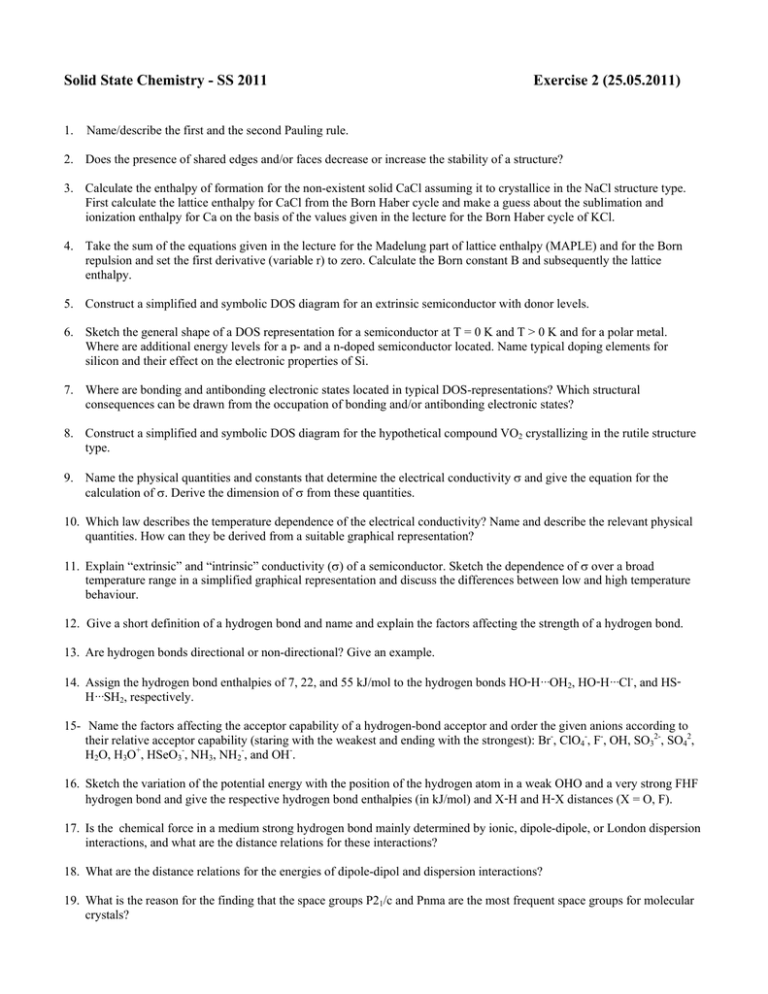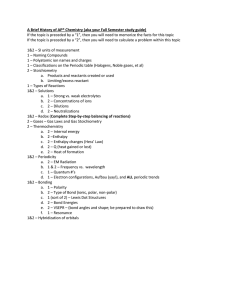Solid State Chemistry - SS 2011 Exercise 2
advertisement

Solid State Chemistry - SS 2011 1. Exercise 2 (25.05.2011) Name/describe the first and the second Pauling rule. 2. Does the presence of shared edges and/or faces decrease or increase the stability of a structure? 3. Calculate the enthalpy of formation for the non-existent solid CaCl assuming it to crystallice in the NaCl structure type. First calculate the lattice enthalpy for CaCl from the Born Haber cycle and make a guess about the sublimation and ionization enthalpy for Ca on the basis of the values given in the lecture for the Born Haber cycle of KCl. 4. Take the sum of the equations given in the lecture for the Madelung part of lattice enthalpy (MAPLE) and for the Born repulsion and set the first derivative (variable r) to zero. Calculate the Born constant B and subsequently the lattice enthalpy. 5. Construct a simplified and symbolic DOS diagram for an extrinsic semiconductor with donor levels. 6. Sketch the general shape of a DOS representation for a semiconductor at T = 0 K and T > 0 K and for a polar metal. Where are additional energy levels for a p- and a n-doped semiconductor located. Name typical doping elements for silicon and their effect on the electronic properties of Si. 7. Where are bonding and antibonding electronic states located in typical DOS-representations? Which structural consequences can be drawn from the occupation of bonding and/or antibonding electronic states? 8. Construct a simplified and symbolic DOS diagram for the hypothetical compound VO2 crystallizing in the rutile structure type. 9. Name the physical quantities and constants that determine the electrical conductivity and give the equation for the calculation of . Derive the dimension of from these quantities. 10. Which law describes the temperature dependence of the electrical conductivity? Name and describe the relevant physical quantities. How can they be derived from a suitable graphical representation? 11. Explain “extrinsic” and “intrinsic” conductivity () of a semiconductor. Sketch the dependence of over a broad temperature range in a simplified graphical representation and discuss the differences between low and high temperature behaviour. 12. Give a short definition of a hydrogen bond and name and explain the factors affecting the strength of a hydrogen bond. 13. Are hydrogen bonds directional or non-directional? Give an example. 14. Assign the hydrogen bond enthalpies of 7, 22, and 55 kJ/mol to the hydrogen bonds HO-H···OH2, HO-H···Cl-, and HSH···SH2, respectively. 15- Name the factors affecting the acceptor capability of a hydrogen-bond acceptor and order the given anions according to their relative acceptor capability (staring with the weakest and ending with the strongest): Br-, ClO4-, F-, OH, SO32-, SO42, H2O, H3O+, HSeO3-, NH3, NH2-, and OH-. 16. Sketch the variation of the potential energy with the position of the hydrogen atom in a weak OHO and a very strong FHF hydrogen bond and give the respective hydrogen bond enthalpies (in kJ/mol) and X-H and H-X distances (X = O, F). 17. Is the chemical force in a medium strong hydrogen bond mainly determined by ionic, dipole-dipole, or London dispersion interactions, and what are the distance relations for these interactions? 18. What are the distance relations for the energies of dipole-dipol and dispersion interactions? 19. What is the reason for the finding that the space groups P21/c and Pnma are the most frequent space groups for molecular crystals?






